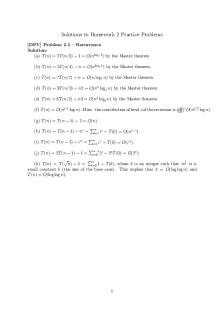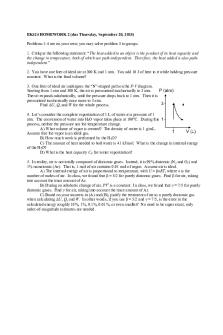6414 HW2 Peer Solutions SP2021 PDF

| Title | 6414 HW2 Peer Solutions SP2021 |
|---|---|
| Author | Lilian Singen |
| Course | Regression Analysis |
| Institution | Georgia Institute of Technology |
| Pages | 9 |
| File Size | 232 KB |
| File Type | |
| Total Downloads | 39 |
| Total Views | 143 |
Summary
HW2 Peer Solutions...
Description
Peer Grader Guidance Please review the student expectations for peer review grading and peer review comments. Overall, we ask that you score with accuracy. When grading your peers, you will not only learn how to improve your future homework submissions but you will also gain deeper understanding of the concepts in the assignments. When assigning scores, consider the responses to the questions given your understanding of the problem and using the solutions as a guide. Moreover, please give partial credit for a concerted effort, but also be thorough. Add comments to your review, particularly when deducting points, to explain why the student missed the points. Ensure your comments are specific to questions and the student responses in the assignment.
Background You have been contracted as an healthcare consulting company to understand the factors on which the pricing of health insurance depends.
Data Description The data consists of a data frame with 1338 observations on the following 7 variables: 1. 2. 3. 4. 5. 6. 7.
price: Response variable ($) age: Quantitative variable sex: Qualitative variable bmi: Quantitative variable children: Quantitative variable smoker: Qualitative variable region: Qualitative variable
Instructions on reading the data To read the data in R, save the file in your working directory (make sure you have changed the directory if different from the R working directory) and read the data using the R function read.csv() insurance = read.csv("insurance.csv", head = TRUE) head(insurance) ## ## ## ## ## ## ##
1 2 3 4 5 6
age sex bmi children smoker region price 19 female 27.900 0 yes southwest 16884.924 18 male 33.770 1 no southeast 1725.552 28 male 33.000 3 no southeast 4449.462 33 male 22.705 0 no northwest 21984.471 32 male 28.880 0 no northwest 3866.855 31 female 25.740 0 no southeast 3756.622
Question 1: Exploratory Data Analysis [12 points] a. 3 pts Create plots of the response, price, against three quantitative predictors age, bmi, and children. Describe the general trend (direction and form) of each plot.
1
# Grid the plots par(mfrow=c(2,2)) # Plot price vs age plot(price~age, data=insurance, main="Price vs. Age", col="grey", pch = 16) abline(lm(price~age, data=insurance), col="red") # Plot price vs bmi plot(price~bmi, data=insurance, main="Price vs. BMI",col="grey", pch = 16) abline(lm(price~bmi, data=insurance), col="red") # Plot price vs children plot(price~children, data=insurance, main="Price vs. Children",col="grey", pch = 16) abline(lm(price~children, data=insurance), col="red")
40000 0
price
40000
Price vs. BMI
0
price
Price vs. Age
20
30
40
50
60
20
age
30
40
50
bmi
40000 0
price
Price vs. Children
0
1
2
3
4
5
children General trend: There appears to be a positive and linear relationship between the response, price, and the predictor variable age. For the relationship between price and the other two predictor variables, bmi and children, it is much less clear. There seem to be a very slight positive linear relationships for each, but there is a lot of extra noise. More analysis and would need to be done to determine the strength of the relationships. b. 3 pts What is the value of the correlation coefficient for each of the above pair of response and predictor variables? What does it tell you about your comments in part (a). # Print the correlation coefficients between the predictors and the response cat("cor(price, age):", cor(insurance$price, insurance$age)[1], end="\n") ## cor(price, age): 0.2990082 2
cat("cor(price, bmi):", cor(insurance$price, insurance$bmi)[1], end="\n") ## cor(price, bmi): 0.198341 cat("cor(price, children):", cor(insurance$price, insurance$children)[1], end="\n") ## cor(price, children): 0.06799823 The correlation coefficient between price and age (0.2990082) is the highest of the group. This isn’t particularly high, but it does communicate that a moderate positive linear relationship between the two variables. The correlation coefficient between price and bmi (0.198341) shows a slight positive linear relationship, and the correlation coefficient between price and children (0.06799823) shows that there is almost no relationship between the two variables. These results reinforces that our comments about the general trend for the price vs. age and price vs. bmi plots were correct, but it shows that there might be almost no relationship between price and children. Outside of that, our analysis aligns with our hypothesis that the response is positively correlated with each of the predictor variables. c. 3 pts Create box plots of the response, price, and the three qualitative predictors sex, smoker, and region. Based on these box plots, does there appear to be a relationship between these qualitative predictors and the response? par(mfrow=c(1,3)) #make categorical variables into factors insurance$sex...
Similar Free PDFs

6414 HW2 Peer Solutions SP2021
- 9 Pages

HW2 solutions
- 6 Pages

8010 hw2 solutions
- 3 Pages

Hw2 practice solutions
- 2 Pages

Hw-2 sol - hw2 solutions
- 7 Pages

EK424 HW2+solutions - Fall 2018
- 6 Pages

Hw2 solutions - hw 2 solu
- 4 Pages

HW2 Fin305 - HW2
- 3 Pages

Hw2 solution - hw2
- 5 Pages

HW2
- 12 Pages

Peer Eval - peer eval
- 2 Pages

GERO315 Sp2021 lab manual
- 28 Pages

Syllabus sp2021 (10)
- 8 Pages

HW2 - gfhfghfgh
- 4 Pages

Hw2 solution
- 5 Pages
Popular Institutions
- Tinajero National High School - Annex
- Politeknik Caltex Riau
- Yokohama City University
- SGT University
- University of Al-Qadisiyah
- Divine Word College of Vigan
- Techniek College Rotterdam
- Universidade de Santiago
- Universiti Teknologi MARA Cawangan Johor Kampus Pasir Gudang
- Poltekkes Kemenkes Yogyakarta
- Baguio City National High School
- Colegio san marcos
- preparatoria uno
- Centro de Bachillerato Tecnológico Industrial y de Servicios No. 107
- Dalian Maritime University
- Quang Trung Secondary School
- Colegio Tecnológico en Informática
- Corporación Regional de Educación Superior
- Grupo CEDVA
- Dar Al Uloom University
- Centro de Estudios Preuniversitarios de la Universidad Nacional de Ingeniería
- 上智大学
- Aakash International School, Nuna Majara
- San Felipe Neri Catholic School
- Kang Chiao International School - New Taipei City
- Misamis Occidental National High School
- Institución Educativa Escuela Normal Juan Ladrilleros
- Kolehiyo ng Pantukan
- Batanes State College
- Instituto Continental
- Sekolah Menengah Kejuruan Kesehatan Kaltara (Tarakan)
- Colegio de La Inmaculada Concepcion - Cebu
